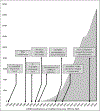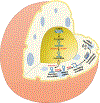Targeting Akt-associated microRNAs for cancer therapeutics
- PMID: 33347867
- PMCID: PMC8187261
- DOI: 10.1016/j.bcp.2020.114384
Targeting Akt-associated microRNAs for cancer therapeutics
Abstract
The uncontrolled growth and spread of abnormal cells because of activating protooncogenes and/or inactivating tumor suppressor genes are the hallmarks of cancer. The PI3K/Akt signaling is one of the most frequently activated pathways in cancer cells responsible for the regulation of cell survival and proliferation in stress and hypoxic conditions during oncogenesis. Non-coding RNAs are a large family of RNAs that are not involved in protein-coding, and microRNAs (miRNAs) are a sub-set of non-coding RNAs with a single strand of 18-25 nucleotides. miRNAs are extensively involved in the post-transcriptional regulation of gene expression and play an extensive role in the regulatory mechanisms including cell differentiation, proliferation, apoptosis, and tumorigenesis. The impact of cancer on mRNA stability and translation efficiency is extensive and therefore, cancerous tissues exhibit drastic alterations in the expression of miRNAs. miRNAs can be modulated by utilizing techniques such as miRNA mimics, miRNA antagonists, or CRISPR/Cas9. In addition to their capacity as potential targets in cancer therapy, they can be used as reliable biomarkers to diagnose the disease at the earliest stage. Recent evidence indicates that microRNA-mediated gene regulation intersects with the Akt pathway, forming an Akt-microRNA regulatory network. miRNAs and Akt in this network operate together to exert their cellular tasks. In the current review, we discuss the Akt-associated miRNAs in several cancers, their molecular regulation, and how this newly emerging knowledge may contribute greatly to revolutionize cancer therapy.
Keywords: Akt; Biomarkers; Cancer; MicroRNAs; RNA-therapeutics.
Copyright © 2020 Elsevier Inc. All rights reserved.
Conflict of interest statement
Declaration of Competing Interest
The authors declare that they have no known competing financial interests or personal relationships that could have appeared to influence the work reported in this paper.
Figures
Similar articles
-
The Akt-associated microRNAs.Cell Mol Life Sci. 2012 Nov;69(21):3601-12. doi: 10.1007/s00018-012-1129-8. Epub 2012 Aug 31. Cell Mol Life Sci. 2012. PMID: 22936352 Free PMC article. Review.
-
Exosomal microRNA as a key regulator of PI3K/AKT pathways in human tumors.Med Oncol. 2024 Oct 14;41(11):265. doi: 10.1007/s12032-024-02529-9. Med Oncol. 2024. PMID: 39400677 Review.
-
The emerging role of non-coding RNAs in the regulation of PI3K/AKT pathway in the carcinogenesis process.Biomed Pharmacother. 2021 May;137:111279. doi: 10.1016/j.biopha.2021.111279. Epub 2021 Jan 23. Biomed Pharmacother. 2021. PMID: 33493969 Review.
-
Comprehensive analysis of microRNA-regulated protein interaction network reveals the tumor suppressive role of microRNA-149 in human hepatocellular carcinoma via targeting AKT-mTOR pathway.Mol Cancer. 2014 Nov 26;13:253. doi: 10.1186/1476-4598-13-253. Mol Cancer. 2014. PMID: 25424347 Free PMC article.
-
Role of Regulatory Oncogenic or Tumor Suppressor miRNAs of PI3K/AKT Signaling Axis in the Pathogenesis of Colorectal Cancer.Curr Pharm Des. 2018;24(39):4605-4610. doi: 10.2174/1381612825666190110151957. Curr Pharm Des. 2018. PMID: 30636581 Review.
Cited by
-
The essential roles of lncRNAs/PI3K/AKT axis in gastrointestinal tumors.Front Cell Dev Biol. 2024 Aug 5;12:1442193. doi: 10.3389/fcell.2024.1442193. eCollection 2024. Front Cell Dev Biol. 2024. PMID: 39161590 Free PMC article. Review.
-
Epigenetic modifications: Critical participants of the PD‑L1 regulatory mechanism in solid tumors (Review).Int J Oncol. 2022 Nov;61(5):134. doi: 10.3892/ijo.2022.5424. Epub 2022 Sep 21. Int J Oncol. 2022. PMID: 36129152 Free PMC article. Review.
-
Profiling of Serum Extracellular Vesicles Reveals miRNA-4525 as a Potential Biomarker for Advanced Renal Cell Carcinoma.Cancer Genomics Proteomics. 2021 May-Jun;18(3):253-259. doi: 10.21873/cgp.20256. Cancer Genomics Proteomics. 2021. PMID: 33893078 Free PMC article.
-
Active surveillance in long period of total neoadjuvant therapy in rectal cancer: Early prediction of poor regression response.Front Oncol. 2022 Nov 10;12:1049228. doi: 10.3389/fonc.2022.1049228. eCollection 2022. Front Oncol. 2022. PMID: 36439518 Free PMC article.
-
RNA therapeutics: From biochemical pharmacology to technology development and clinical applications.Biochem Pharmacol. 2021 Jul;189:114567. doi: 10.1016/j.bcp.2021.114567. Epub 2021 Apr 16. Biochem Pharmacol. 2021. PMID: 33865832 Free PMC article. No abstract available.
References
-
- Wang JJ, Lei KF, Han F, Tumor microenvironment: recent advances in various cancer treatments, Eur. Rev. Med. Pharmacol. Sci 22 (12) (2018) 3855–3864. - PubMed
-
- Wang D, Gu J, Wang T, Ding Z, OncomiRDB: a database for the experimentally verified oncogenic and tumor-suppressive microRNAs, Bioinformatics 30 (15) (2014) 2237–2238. - PubMed
-
- Zhang WL, Zhao YN, Shi ZZ, Cong D, Bai YS, Lutein inhibits cell growth and activates apoptosis via the PI3K/AKT/mTOR signaling pathway in A549 human non-small-cell lung cancer cells, J. Environ. Pathol. Toxicol. Oncol 37 (4) (2018) 341–350. - PubMed
-
- Qadir MI, Usman M, Akash MSH, Transposable elements (human endogenous retroviruses) in cancer, Crit. Rev. Eukaryot. Gene Expr 27 (3) (2017) 219–227. - PubMed
Publication types
MeSH terms
Substances
Grants and funding
LinkOut - more resources
Full Text Sources
Other Literature Sources
Medical





